I think i’ll have to put a stop soon-ish to this avalanche of posts about ARCO, the contemporary art fair that closed 10 days ago in Madrid. But there’s still a couple of stories i owe you. On top of the list is a report on Expanded Box, ARCO’s section that specializes in new media art and video art. I’ll focus on the former. Obviously.
Art critic and curator Domenico Quaranta curated the programme with an eye on selecting artworks that feature both a marketable appeal and a critical approach of the cultural impacts of media and technologies. I think Quaranta was the ideal man for the job. He’s digustingly young and as such doesn’t come with the preconception and ‘burden’ of the old new media art crowd. He’s nevertheless extremely well informed, respected by the nma family and has proved his caliber on several occasions, in particular last year when he curated Holy Fire, art of the digital age together with Yves Bernard at iMAL in Brussels. Everthing could only run smoothly….
The press release quotes Quaranta who explains that the programme “showcases a type of art that looks outside the parameters of contemporary art to art developed on the Net, the art produced in research centres and labs and that has all the potential to change our present-day notion of art. A change of perspective that should not scare collectors or art lovers, because these works are representative of the information society and of the globalised world we all live in.”
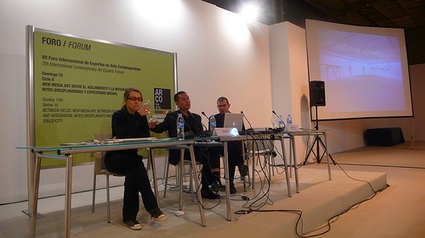 Joasia Krysa, Zhang Ga and Domenico Quaranta
Joasia Krysa, Zhang Ga and Domenico Quaranta
Before i give more details about the artworks exhibited, allow me to write a few words about the experts’ forum i participated to. Between Fields, New Media Art Between Isolation and Integration, Inter-disciplinarity and Media Specificity, chaired by Domenico Quaranta.
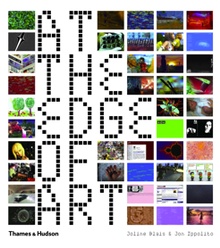
Because i had been suffering from a particularly vicious flu that week, i had to miss the first presentations.
Fortunately, Geert Lovink dedicated a blog entry titled Discussing the Crisis in New Media Art @ ARCO Madrid to the talks of Joline Blais and Jon Ippolito , the charming and witty authors of the book At the Edge of Art, and to the one of Roberta Bosco, a journalist who has been covering media art for the mainstream and more specialized Spanish and Italian press with a remarkable knowledge and passion for the genre.
 U.S. Patent and Trademark Office certificate, 1998 – 2004
U.S. Patent and Trademark Office certificate, 1998 – 2004
I regrettably missed Geert Lovink’s talk. But i did catch the following speakers:
– Inke Arns explained the remarkable work she’s doing at HMKV in Dortmund, in particular the exhibitions History will repeat itself (i raved about it in part 1 and part 2 of my report) and Anna Kournikova Deleted By Memeright Trusted System – Art in the Age of Intellectual Property. They published the catalog of the exhibition as a downloadable PDF and i can’t think of a better way to spend your weekend than by reading through it. That’s what i’m planning on doing today.
HMKV has a talent for showing new media art works in a ‘transversal’ and very approachable way. The exhibitions of the Dortmund center focus on phenomenon that go way beyond the new media art sphere and take technology and media as a starting point to demonstrate their wide-ranging imprint on culture and life in general. Inke Arns illustrated that point with one example taken from the show Art in the Age of Intellectual Property: a copy of the U.S. Patent and Trademark Office certificate. Kembrew McLeod, a professor of Communication Studies at the University of Iowa but also a prankster, trademarked in 1998 the phrase “Freedom of Expression®” as a comment on how the intellectual property law is being used to fence off culture and restrict the way in which people can express their ideas.
Trailer of the documentary Freedom of Expression based on McLeod’s book of the same title:
After Inke it was my turn. I’ll spare you that part and offer you a video of dazzling Demis.
Media artist and curator Zhang Ga gave a wonderfully well-researched presentation on the many links that tie closely new media art with other art forms, demonstrating how much media art refers to and owes to many of the most important contemporary art movements. Zhang Ga also gave an overview of Synthetic Times – Media Art China at the National Art Museum of China in Beijing (part 1 and part 2 of my review of the show). Finally he mentioned the art fair dedicated to new media art galleries that he is curating in Shanghai.
Joasia Krysa was the last to speak. She analyzed brilliantly Cao Fei‘s RMB City and its bankable success, both online and offline.
Now a quick selection of the pieces shown in the Expanded Box exhibition:
One of the most popular art pieces of the Expanded Box section was a 3D animation piece by John Gerrard, on view at the booth of Galerie Ernst Hilger contemporary.
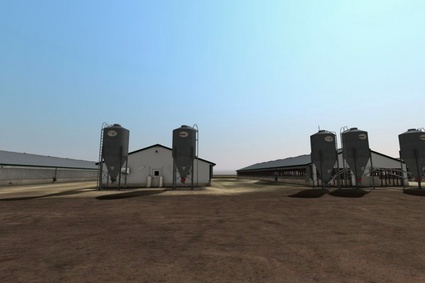 John Gerrard, Grow/Finish Unit (Eva, Oklahoma), 2008
John Gerrard, Grow/Finish Unit (Eva, Oklahoma), 2008
Grow / Finish Unit (Eva, Oklahoma) 2008, is a representation of an unmanned pig production site near to Boise City, Oklahoma. The scene represented unfolds in real time over the course of one year, its light conditions through dawn and dusk match that of the local site.
At this start of the industrialised food production chain, pigs are raised on corn which is grown using nitrogen derived from oil and gas, thus rendering the occupants of these sheds in essence, oil derived pigs.
At no point are the many thousands of occupants of the eight sheds visible, as this is the case in reality. An autonomous virtual wind animates the surface dust, creating the principal movements in the piece. However, a single transport truck pulls to each building every 6-8 months and waits for 1 hour.
As in many of the artist‘s works the public can manipulate the frame to navigate a large arc around the scene.
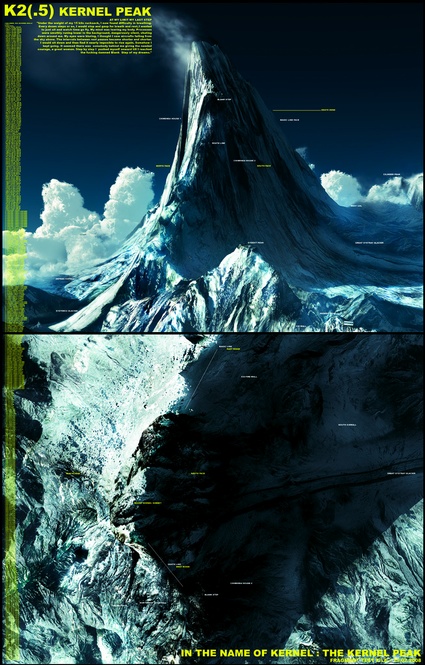 Joan Leandre, In the Name of Kernel – Kernel Peak – At My Limit, 2008. Courtesy Project Gentili, Prato (Italy)
Joan Leandre, In the Name of Kernel – Kernel Peak – At My Limit, 2008. Courtesy Project Gentili, Prato (Italy)
Joan Leandre had a spectacularly suggesting video at Project Gentili. The piece puts viewers inside an unmanned flying vehicle that slowly glide over locations that are part of everybody’s culture (from Disneyland to Chernobyl) yet, acquire an uncanny pattern when seem from above.
Check out rhizome’s interview with Joan Leandre and the PDF catalogue of the exhibition, it’s bilingual italian / english.
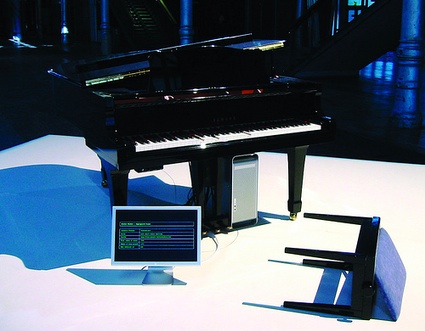 Thomson & Craighead, Unprepared Piano, 2004. Baby grand piano, software application, computer, dimensions variable. Courtesy ARC Project, Sofia (Hungary)
Thomson & Craighead, Unprepared Piano, 2004. Baby grand piano, software application, computer, dimensions variable. Courtesy ARC Project, Sofia (Hungary)
Thomson & Craighead‘ homage to John Cage’s Prepared Piano (a piano with its sound altered by placing various objects in the strings) was minding its own business at the booth of the ARC Projects gallery from Sofia. Unprepared Piano is connected to a database of music MIDI files compiled from the web, no matter whether they have been intended for piano only or for a variety of instruments. The electronic scores are then “performed” automatically according to a simple set of rules.
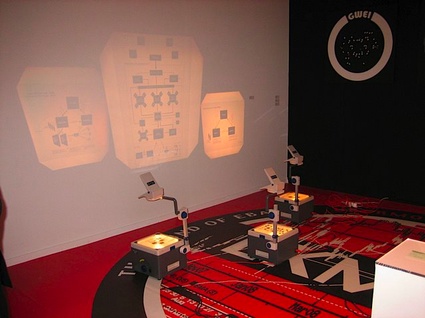 Expanded Box – UBERMORGEN.COM’s EKMRZ Trilogy. Photo Domenico Quaranta
Expanded Box – UBERMORGEN.COM’s EKMRZ Trilogy. Photo Domenico Quaranta
UBERMORGEN.COM‘s EKMRZ Trilogy engages in a shrewd and critical with the cultural consequences of media and technologies. The booth of Fabio Paris Art Gallery which hosted their installation was certainly the most creatively designed of the section . One of the pieces exhibited was awareded the ARCO Beep new media award this year.
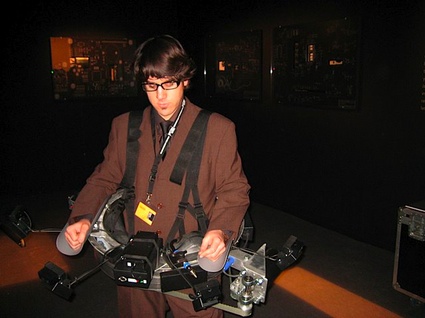 Curator Pau Waelder trying Compass, by Lawrence Malstaf. Photo Domenico Quaranta
Curator Pau Waelder trying Compass, by Lawrence Malstaf. Photo Domenico Quaranta
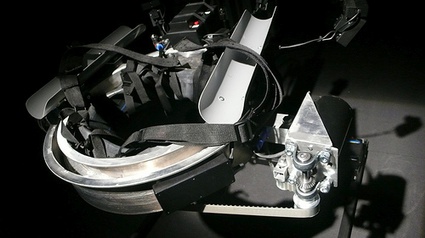
The award for the ‘artwork everybody wanted to try’ goes to Compass by Belgian artist Lawrence Malstaf and presented at the booth of the Fortlaan 17 gallery.
Domenico Quaranta images
